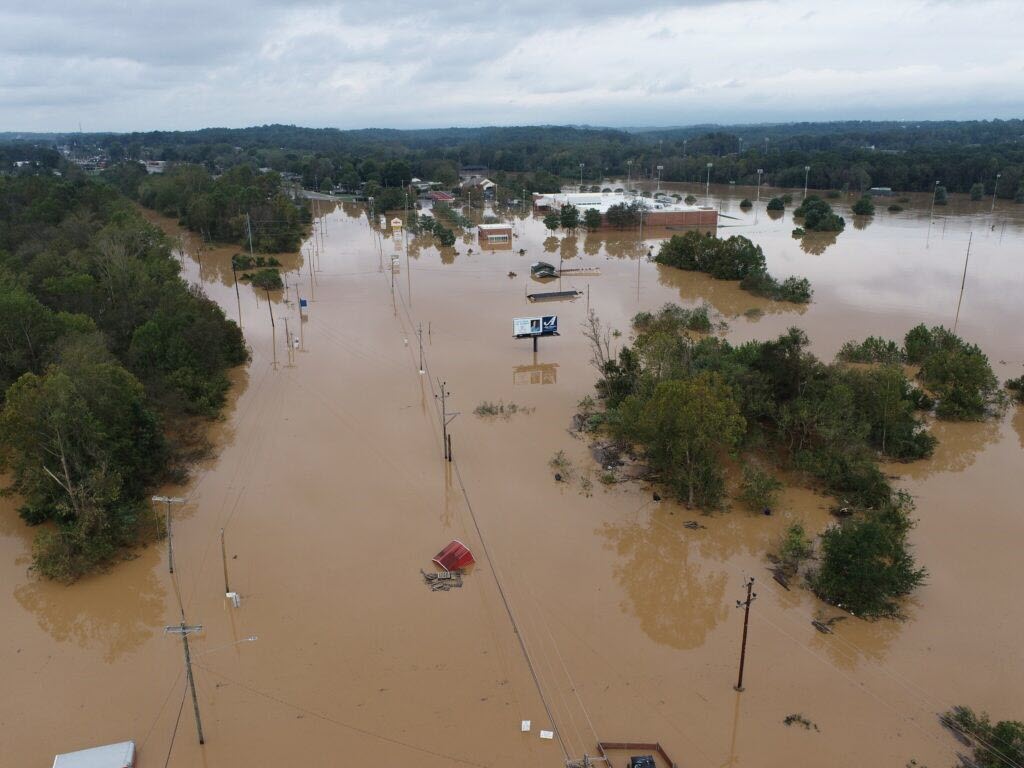 NC DOT
NC DOT The autoreply was as frightening as it was reassuring.
ASCE members looking to get in touch with longtime ASCE North Carolina leader John Garner, P.E., M.ASCE (most recently a Region 4 governor) at his Asheville home this past weekend received an out-of-office response. It said that he was OK but currently without power and water.
Such was the case for tens of thousands of people in the western part of North Carolina, along with areas across the Southeast United States, as Hurricane Helene unleashed flooding throughout Friday and Saturday, leading to failed dams, bridges, and roads and untold loss of lives and property.
“Many people have been left without power and even cell service in the whole region – even those that weren’t directly affected by the flooding,” said Ned Mueller, P.E., M.ASCE, North Carolina Section president. “The effects on infrastructure have been massive with many communities being cut off. Even as the water is receding, some of the roads will continue to be impassable due to bridge and road failures. We can expect this to be a long and difficult recovery for many communities with a lot of hard work for civil engineers to do in several disciplines.”
In North Carolina, Helene arrived when the entire state was already dealing with abnormally high rainfall this summer. About 250 miles east of Asheville, the Raleigh-Durham area had already seen 28 inches of rain since June, when the area expected to get about 14.
“I work in stormwater, so I have seen firsthand the impacts of all this rain on the community of Raleigh and greater Wake County,” said Charles “Chas” Webb, P.E., M.ASCE, a Region 4 governor for ASCE. “We’ve seen doubling out of calls we would normally see between July 1 and Sept. 30.”
Boone, Asheville, and other cities along the western border of North Carolina and eastern Tennessee are mountainous and have complicated terrain with many bodies of water, and it all took on record-breaking levels of rain from Helene.
“In the western part of the state, you see a little bit more flash flooding because of its narrow valleys,” Webb said. “There’s nowhere for the water to go because there’s just steep cliffs.
“Another thing to consider is emergency access. A lot of these communities have one road in, one road out. Unlike in Raleigh, where we have interconnected thoroughfares that allow for multiple emergency routes.”
Webb said the Raleigh stormwater design manuals are typically built around 2- and 10-year storms. It’s not so easy – or cost-effective – to design everything for the 100-year storm, he said.
“That system definitely got overwhelmed, but it’s very hard to design for those storms,” Webb said. “And another thing you have to consider is the maintenance of those systems.
“A pipe is only going to work as long as it’s not locked. If it’s clogged, there’s not much you can do in terms of design for that. So maintenance of those existing systems is critical too, and, for a lot of these rural communities, you don’t quite have the budget of a, say, city of Raleigh. That can be very difficult on them, and these things happen.”
 NC DOT
NC DOT Finding solutions
Further south, in Georgia, residents are reeling from widespread storm damage, particularly power outages.
“Georgia Power has determined Hurricane Helene was the most destructive hurricane in our history,” said Melissa Wheeler Black, M.ASCE, a former Region 5 director who works as a transmission project manager for the Georgia Power Company, focused on DOT projects.
“One of the issues with this storm is that we had significant damage to our transmission lines (>46kV). These are like the interstates of the power grid. We had to get these lines repaired and energized to serve the substations that deliver power to residential and commercial customers. In my 29-plus years at GPC, I’ve never seen impacts like this to our transmission system.”
Civil engineers around the southeast have sprung to action, aiding recovery in a variety of ways, especially in getting infrastructure systems online and resilient again. It’s not easy, though. For Black, the sheer logistics involved can make one’s head spin.
“In the days leading up to the storm, we stage crews, engineers, logistics support, and damage assessment teams in areas where they can begin to work immediately after the storm passes,” Black said. “It’s a major effort to have employees and 14,000-plus contractors working across the state. In addition to repairing the powerlines, we have to shelter and feed everyone involved in the storm effort.
“Everyone has a role to play in storm restoration. Storm response involves very long days, but it is rewarding to help get the lights back on. It’s what we do.”
Back in North Carolina, with more rain in the forecast this week, Webb said moments like this remind civil engineers that their profession is all about people, taking care of people like John Garner, who reports “OK but without power and water.”
“It really is a human response first and foremost,” Webb said. “It’s about trying to take care of the basic needs of people – food, shelter, water, electricity. And as an ASCE Section board, we’ll meet and see what we can do. As civil engineers, we’ll help build and recover. But right now, we need to simply make sure people are OK and safe.”
Read ASCE's statement on the storms from Society President Marsia Geldert-Murphey.
Read more about mitigating flood risk in a special collection in the ASCE Library.
Ways you can help
- Manna Food Bank – Distributing food to those in need in Asheville, North Carolina. Donate at the website.
- Virginia's Mountain Playground – Disaster relief fund for Giles County, Virginia. Donate and volunteer at the website.
- Second Harvest Food Bank of East Tennessee – Providing "Help After Helene" meals in eastern Tennessee. Donate at the website.
- Mercy Chefs –Hot meals for those in need in Asheville and Newberry, Florida, affected by Helene. Donate at the website.
- American Red Cross – Food, shelter, supplies, and emotional support. Give to the national group's Helene relief efforts.
- United Way – Short-term relief and help for survivors later. Find a local chapter to donate.
- The Salvation Army – Food, shelter, emotional, and spiritual care and other emergency services for survivors and rescue workers. Donate to Helene efforts.
- World Central Kitchen – Chef José Andrés’ teams set up temporary kitchens to serve meals to victims and responders. Donate at their website.
- Americares – Providing post-disaster medicine, personal protective equipment, and medical supplies. Give at its Helene donation page.
- Save the Children – Providing child-focused supplies to storm-hit families including hygiene kits, diapers and baby wipes, plus classroom cleaning kits to schools, and helps restore child care and early learning centers. Give to its Children's Emergency Fund.



